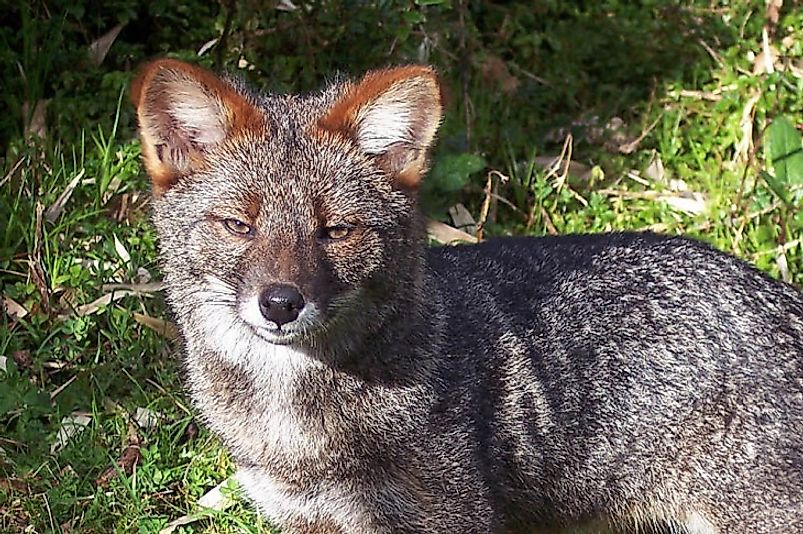Chile's Most Endangered Mammals

Chile is a South American country situated between the Pacific Ocean and the Andes Mountains. The country is bordered by the maritime Drake Passage, and the countries of Bolivia, Argentina, and Peru. Chile claims more than one million square kilometers of the continent of Antarctica despite those claims being suspended under the Antarctic Treaty. Chile has a vast biodiversity including number of endangered species. Darwin's Foxes, Short-Tailed Chinchillas, Long-Tailed Chinchillas, and Pacific Degu are critically endangered in Chile among other mammals.
Short-Tailed Chinchilla (Chinchilla brevicaudata)
The Short-tailed Chinchilla is an endangered species of rodents whose native habitats include Chile, Peru, and the Andes Mountains regions of Argentina and Bolivia. Short-tailed chinchilla measures between 28 centimeters and 49 centimeters long, and weighs between 38 and 50 ounces. The Short-Tailed Chinchilla has short front legs and long and strong hind legs. Chinchillas burrow under the ground and rocks for shelter, mostly living in cold climates to which they are well adapted due to their thick fur. The Chinchillas are social animals who live in large numbers and feed on vegetation. The greatest threat to the Chinchillas is hunting, which has reduced their numbers significantly. Hunting Chinchillas became illegal in 1929 when the first successful protection law was passed, but the laws were not enforced until 1983. A treaty in 1910, between Chile, Peru, Bolivia, and Argentina was the first international attempt at banning commercial hunting of chinchillas. However, this only led to increased prices resulting in a rapid decrease in the remaining Chinchilla population. Both the government of Chile and the International Union for the Conservation of Nature (IUCN) have listed Short-Tailed Chinchillas as an endangered species.
Long-Tailed Chinchilla (Chinchilla lanigera)
Long-Tailed Chinchillas are found around Aucó, near Illapel, in Chile, as well as in the Reserva Nacional Las Chinchillas protected area and the La Higuera area to the north of Coquimbo. The mammal is small in size and has rounded ears and a longer tail as compared to the Short-tailed Chinchilla. The Chinchilla has hair up to between 2 and 4 centimeters long with gray, white, and black bands, and it is also silky and incredibly soft. Long-tailed chinchillas breed between October and December during the spring months in the Southern Hemisphere. The three different varieties of Long-tailed chinchillas, and these include the La Plata, the Costina, and the Raton subspecies. The La Plata is a muscular and thick boned structure as compared to the other two. It is more roundish, with a short, broad head, a significant distance between its ears and a straight dorsal line, and shoulders as wide as its chest and rump. The Costina is relatively weaker in structure with distinctive long hind legs, shorter front legs with narrow shoulders, sometimes a thick neck and a v-shaped head. The Raton is similar compared to the others, with the ears close together horizontally and distinctively smaller in size. The chinchillas' habitat is quite harsh, with summer temperatures up to 30 Degrees Celsius during the day and dropping to 7 Degrees Celsius at night. It is listed as an endangered species, thus carrying the second-highest conservation priority among Chilean mammals.
Southern River Otter (Lontra provocax)
The Southern River Otter is a species of otter that lives in Chile and Argentina. It inhabits both freshwater and marine environments and is also sometimes considered to be the Lontra Canadensis subspecies. The Southern River Otter's medium sized body can grow up to 70 centimeters long with another 40 centimeters of additional length from its tail, and weighs around 10 kilograms. It has dark brown fur on top and a lighter cinnamon color on its undersides. The females and offspring live in family groups, while the male lives in solitude, and they feed on crustaceans, fish, mollusks, and birds. The Otter can be found in marine, freshwater, and terrestrial habitats, although they are mostly found in freshwater lakes and rivers which have dense vegetation, especially along the shorelines. Their habitats also need the root systems of mature trees, as well as fallen tree debris. South river otters were hunted for their pelts over the last one hundred years, and have never been able to fully recover. There are only seven known species found throughout Chile and Argentina, which are isolated from each other and was listed as endangered species.
Pacific Degu (Octodon pacificus)
The Pacific Degu is a species of rodent in the Family Octodontidae. The Degu’s natural habitat is Chile's subtropical or tropical moist lowland forests. The greatest threat to the Degu was habitat loss. The Degu is active at day, with actively relative primitive octodontid features it has long fur and a tail that lacks in sufficient tuft. The Degu has been classified as an endangered species.
Environmental Threats and Conservation Efforts
These and other endangered mammal species of Chile have been significantly reduced in number due to human interference, and because of it certain conservation laws have been put into place to help preserve their populations. Their aim to regulate and protect the remaining population of these endangered mammals. There a total of 9 most endangered mammal species in Chile.
Chile's Most Endangered Mammals
| Chile's Most Endangered Mammals | Scientific Name |
|---|---|
| Short-tailed Chinchilla | Chinchilla brevicaudata |
| Long-Tailed Chinchilla | Chinchilla lanigera |
| Pacific Degu | Octodon pacificus |
| Darwin's Fox | Lycalopex fulvipes |
| Smoky Bat | Amorphochilus schnablii |
| Andean Mountain Cat | Leopardus jacobita |
| Marine Otter | Lontra felina |
| Southern River Otter | Lontra provocax |
| South Andean Deer | Hippocamelus bisulcus |







